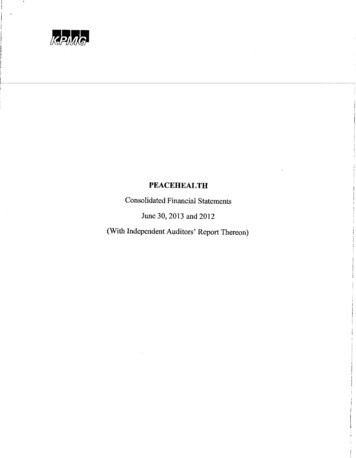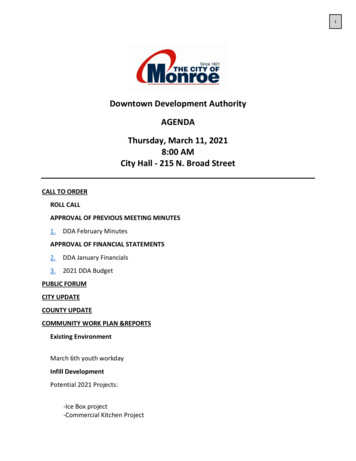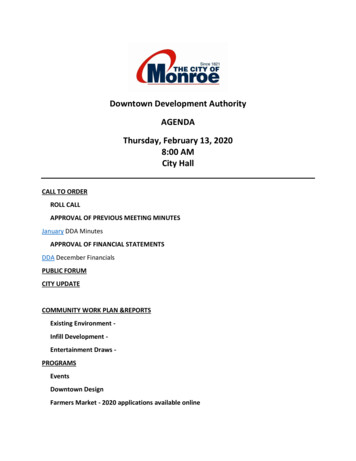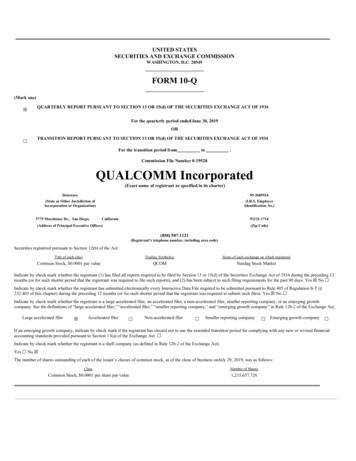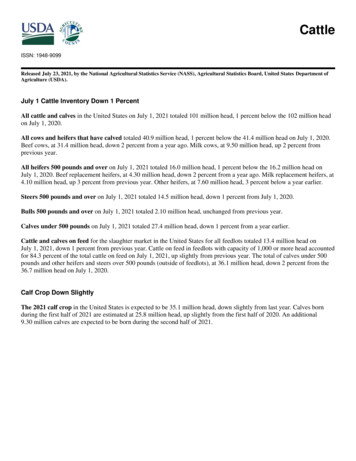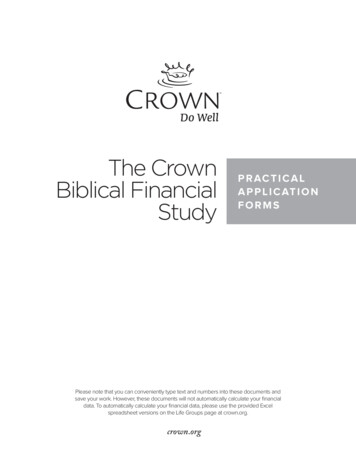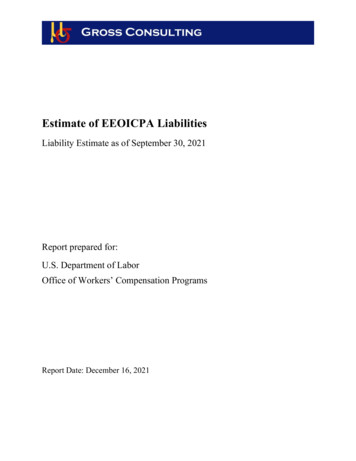
Transcription
Estimate of EEOICPA LiabilitiesLiability Estimate as of September 30, 2021Report prepared for:U.S. Department of LaborOffice of Workers’ Compensation ProgramsReport Date: December 16, 2021Christopher Gross Consulting, Inc. 332 Minnesota Street, Suite W2700 Saint Paul, MN 55101 www.cgconsult.com
December 16, 2021Eric HillComptroller, Division of Financial AdministrationOffice of Workers’ Compensation ProgramsUS Department of LaborFrances Perkins Building200 Constitution Ave NWWashington DC 20210Re: Estimate of EEOICPA Liabilities as of September 30, 2021Dear Mr. Hill:Attached is the actuarial report documenting our analysis of the EEOICPA liabilities as ofSeptember 30, 2021. If there are any questions regarding this report or the analysis which itdocuments, I can be reached by telephone at (651) 293-8008 or by email atchris.gross@cgconsult.com.Sincerely,Chris Gross, ACAS, MAAAPresident and CEOJennifer NelsonSenior Vice PresidentCG/jnChristopher Gross Consulting, Inc. 332 Minnesota Street, Suite W2700 Saint Paul, MN 55101 www.cgconsult.com
Table of ContentsIntroduction . 4Distribution and Use . 4Qualification . 4Executive Summary . 5Discounted Cash Flow by Year . 6Summary of Changes . 7Actual vs Projected . 8Number of Cases Approved . 8The EEOICPA Model . 91: Organize and Aggregate the Data . 102: Estimate the number of Future Approved Cases . 113: Estimate the average compensation payment per case . 164: Payout patterns . 175: Estimate the number of cases eligible for medical benefits . 186: Remove double counting . 197: Mortality . 218: Estimate the Number of Individuals eligible for medical benefits . 229: Estimate Average Medical Payments and Inflation Rates . 2410: Calculate the total expected Medical Payment by year . 2511: Discount the cash flows to 9/30/2021 . 26Hindsight Opinion . 27Appendix 1: Reconciliation of Change in Liability Estimate . 28Appendix 2: Summary of EEOICPA Model Assumptions . 29Appendix 3: Part E Compensation Payments . 31Appendix 4: Undiscounted Liability Estimates . 38Appendix 5: Ranges . 40Christopher Gross Consulting, Inc. 332 Minnesota Street, Suite W2700 Saint Paul, MN 55101 www.cgconsult.com
IntroductionThe Energy Employees Occupational Illness Compensation Program Act (“EEOICPA”) providescompensation and medical benefits to claimants who are (or were) employed in various energy-relatedactivities either directly for the Department of Energy (“DOE”) or through its contractors orsubcontractors. Eligible claimants also include survivors of deceased workers who otherwise would havebeen eligible for benefit payments.The Office of Workers’ Compensation Programs (“OWCP”) at the U.S. Department of Labor maintains amodel to estimate the future liabilities of the EEOICPA program. The OWCP has requested that GrossConsulting review the annual data updates to the model, review the reasonableness of the EEOICPAmodel and assumptions, and recommend enhancements as needed.Distribution and UseThe valuation has been conducted in accordance with all relevant Actuarial Standards of Practice. Thepurpose of the actuarial valuation report is to document the Energy Employees’ Occupational IllnessCompensation Program (“EEOICP”) actuarial liability estimate and the change in the actuarial liability,and to assess the reasonableness of the related assumptions; to assist the U.S. Department of Labor inpreparing the consolidated financial statements, as of and for the fiscal year ended September 30, 2021, inaccordance with U.S. generally accepted accounting principles, as promulgated by the FederalAccounting Standards Advisory Board. We understand a copy of this report may be provided to OWCP’sauditors. If this report is shared, we request that the report be shared in its entirety.QualificationI, Chris Gross, am a member in good standing of the Casualty Actuarial Society and the AmericanAcademy of Actuaries and am qualified to provide this analysis.Chris Gross, ACAS, MAAA4
Executive SummaryPart B of EEOICPA, effective July 31, 2001 provides lump sum compensation of 150,000 and medicalexpenses to employees of the Department of Energy (“DOE”), or its contractors or subcontractors, whodevelop cancer, beryllium disease, or chronic silicosis after working at a covered facility. If the employeeis no longer living, compensation benefits are available to survivors. Part B also covers employees whoare a member of the Special Exposure Cohort (“SEC”). A worker who is included in a designated SECclass of employees, and who is diagnosed with one of 22 specified cancers, may receive a presumption ofcausation under the EEOICPA. The National Institute for Occupational Safety and Health (“NIOSH”) hasresponsibility for designating additional facilities to the SEC.Part E of the Act, effective October 28, 2004, provides wage loss, impairment benefit, and medicalexpenses to employees of the DOE and its contractors and subcontractors, who develop an illness due toexposure to toxic substances at certain DOE worksites. Part E also pays survivor benefits to certainsurvivors. Part E pays a maximum compensation amount of 250,000 per case.As of 9/30/2021, the discounted liability estimate for future EEOICPA benefit payments is 43 billion.The future compensation payments are projected at 8 billion, and the future medical payments areprojected at 35 billion, on a discounted basis. This is a 14.7% increase over the 9/30/2020 liabilityestimate of 37.5 billion, largely driven by the continued increase in utilization of medical services andexpansion of benefits due to increases in acceptances of “consequential conditions” in existing cases.ESTIMATED LIABILITY FOR EEOICPAAS OF SEPTEMBER 30, 2021SUMMARY OF LIABILITY FOR FUTURE PAYMENTS( Millions)Discounted Liability Estimateas of9/30/2021Compensation: Part BCompensation: Part ECompensation: Total Medical PaymentsTotal Future Payments2,9565,1638,119as of9/30/2020 34,918 43,0383,1895,4738,662YOYDifference 28,859 37,521(233)(310)(543)6,059 5,51614.7%The discount rates used for the 9/30/2021 estimate were 2.120% for compensation and 2.384% formedical.5
Discounted Cash Flow by YearThe following exhibits document the estimated cash flows by year, on a discounted basis. Forinformational purposes, the cash flows for the Department of Justice Part B RECA payments aredisplayed in column 4. The RECA compensation liability is included as part of Part B compensationliability in the Executive Summary.ESTIMATED LIABILITY FOR EEOICPAAS OF SEPTEMBER 30, 2021SUMMARY OF DISCOUNTED PAYMENTS BY YEARFiscalYear(1)CompensationPart BDiscountedPayments(2)2022 814,184After 2046203,939,4081Total Future 2,816,064,222CompensationPart EDiscountedPayments(3) ,562,76854,948,170386,363,490 5,162,996,367CompensationDOJ RECADiscountedPayments(4) mpensationTotalDiscountedPayments(4) 28897,779,09189,314,359599,620,898 8,129,800715,133,532673,658,0587,123,612,460 34,918,389,764 ,623762,972,4177,723,233,358 43,037,539,363 11Reflects projected cash flow through 2081Totals may not equal sum of components because of independent rounding6
Summary of ChangesBased on observed trends in the updated EEOICPA data, the following changes in assumptions weremade to the model this year:1. Part B Slight decrease in the projected number of future approved Part B cases Slight increase in the percentage of Part B approvals that are already approved for Part E,and in the estimated percentage of awards that are filed by the employee2. Part E Slight decrease in the projected number of future new cases approved for Part E Increase in the estimated percentage of awards that are filed by the employee3. Medical CostsThe estimated medical inflation rates for future years 1-5 were increased based on guidance fromOWCP management regarding expected utilization of medical services in the short term. Thelong-term inflation rates selected are the CPI-Medical inflation rates from the OMB EconomicAssumptions.Please see Appendix 2 for a listing of the specific values for all assumptions.7
Actual vs ProjectedNumber of Cases ApprovedOverall, there were 28% fewer Part B cases and 14% fewer Part E cases newly approved during 7/1/2020to 6/30/2021 than what was projected. We assume this is largely due to the COVID-19 pandemic, as thenumber of filed claims has decreased since the start of the pandemic.Total Approved Cases 7/1/20 to 6/30/21ProjectedActual@7/2020 @6/2021B: RECA145113B: BD & BS8853B: CS405337B: CNSEC925599B: 21%Part B Total1,9201,384-536-28%Part E2,6792,294-385-14%Cash FlowOverall, the revised cash flow projection for Fiscal Year 2021 is very similar to the amount projected asof 9/30/2020.Benefit Payments FY 2021Projected @9/2020Part B Compensation276,213,806Part E Compensation403,300,174Medical Payments1,033,268,375Total1,712,782,355Actual 9 month Proj 3 mo194,972,199434,139,2951,083,000,0001,712,111,494 )%Diff-29%8%5%0%8
The EEOICPA ModelThe EEOICPA analysis consists of the following steps:1. Organize and aggregate the dataCompensation Benefits2. Estimate the number of future new cases approved3. Estimate the average compensation payout per approved case4. Determine the payout patterns to estimate the compensation cash flow by year5.6.7.8.9.10.Medical BenefitsEstimate the percentage of cases eligible for medical benefitsRemove double counting – cases can be approved for both Part B and Part EApply mortality assumptions to determine the number eligible for medical benefitsEstimate the number of individuals eligible for medical benefitsEstimate the average medical costs and future inflation ratesCalculate the total expected medical payments11. Discount the future payments to 9/30/2021These steps are described in detail in the next sections.9
1: Organize and Aggregate the DataThe EEOICPA analysis is performed using detailed claim-level data extracts provided by the DOL.Data provided includes information on medical payments by case, compensation payments by claimand case, claim disposition status (e.g., approved, denied, pending decision, etc.), and employee datasuch as date of birth, sex, date of death (if known), and survivor information.The data provided for this analysis consists of a series of text data files that were imported into adatabase for further analysis and manipulation. The source data includes the following tables:Table NameBp historyCase mainCausationClaimantEmploymentFDMedicalPayment martRECA eftRECA paper checkDescriptionHistory of medical payments by caseEmployee information by case, includes RECA indicatorAll causation records, includes SEC identifierClaim information included type of claim and filing datesEmployment information for employees, including worksite IDFinal decision table by case, identifies acceptance/denial of filedclaimsMedical information by case, includes disease typeHistory of compensation payments by claimAdditional RECA payments (electronic funds transfer)Additional RECA payments (paper check)The data was then organized through a series of database queries to create summarized tables of newentrants, compensation payments, medical payments, and claims filed by living employees. Thesesummarized tables are checked against the EEOICP Program Statistics2 (as shown in the table below),and then brought into the EEOICPA model to begin the analysis.2The expectation is not that the results will match exactly to the website, but that they will be reasonably close. Dueto the fact that the data may reported a few days apart, and that there may be slightly differing methodologies fordetermining the number of approved cases, a small amount of variance is expected.10
2: Estimate the number of Future Approved CasesTo estimate the number of cases that will be newly approved in the future, the historical number ofnewly-approved cases by quarter is determined in total for Part E and by governing disease for Part B.Part B is split out by governing disease because the compensation payment amounts are different bygoverning disease for Part B.For Part B, an exponential decay model is then fit to the recent history, minimizing the sum ofsquared errors between the actual data and the fitted data, to determine the parameters with the bestfit. Judgment is used to determine how many quarters of recent history should be incorporated intothe fit model, as the rate of decay differs somewhat over time. For the 9/30/2021 liability estimate, themodels are based predominately on the last four or five years of history. For Part E, it is assumed thatthe current rate of awards will continue for the next two years and will then begin to decline.The exhibits on the following pages show a graph of the quarterly history of newly-approved cases,the modeled fit line, as well as the assumed projections (current and prior). Significant actuarialjudgment was used in making these projections, in light of what was believed to be temporarilydepressed approval levels as a result of COVID-19 impacts. Hence the projection will not alwayscoincide with the modeled fit line. We find the selected projections to be reasonable and appropriate.Part B: RECASelected Decay Rates:Number of Part B RECA Approved Cases by 6%6.3%20201.5%5.8%IndicatedPrior 01820172016‐The Part B RECA program currentlyhas a sunset date of July 9, 2022, butis likely to be extended or possiblyexpanded. This actuarial reportassumes that the RECA program willcontinue unchanged.11
Part B: Beryllium DiseaseNumber of Part B Beryllium Disease Cases Approved byQuarter25.0Selected Decay Rates:Indicated20.0Prior 0202019201820172016‐Part B: Beryllium SensitivityNumber of Part B Beryllium Sensitivity Cases Approved byQuarter30Selected Decay rior 242023Part B: Chronic Silicosis20222021202020192018201720160Part B : Chronic SilicosisNumber of Part B Chronic Silicosis Cases Approved by QuarterDue to the recent increase in approvedcases, a curve was not fit to thehistorical data for Part B ChronicSilicosis. Instead, 92 new cases perquarter (average of most recent eightquarters) is projected for FY2022 andFY 2023, with a 2% quarterly decaygoing forward at that r 201820172016012
Part B: Cancer SECNumber of Part B Cancer SEC Cases Approved by QuarterSelected Decay nnualPrior Selection35020211.8%7.0%20201.8%7.0%3300For Cancer SEC, a decay model is fitto recent history, excluding 2021, toestimate future decay rates. Thismethod does not explicitly assume anyfuture new SEC 1202020192018201720160Part B: Cancer Non-SECNumber of Part B Cancer (Non‐SEC) Cases Approved byQuarter160Selected Decay Rates:Actual/Projection140Indicated120Prior Part ENumber of Part E Cases Approved by QuarterDue to the recent dramatic shifts inapproved cases, a curve was not fit tothe historical data for Part E. Instead,621 new cases per quarter (averageof most recent eight quarters) isprojected for FY2022 and FY 2023,with a 2% quarterly decay goingforward at that or 20192018201720163003A new SEC class was designated for the Savannah River Site on September 17th, 2021. Due to the timing of this designationwithin the liability calculation process, this report excludes the additional information pertaining to this SEC. In conversationwith the program management regarding this additional SEC and its relatively small size in comparison to the expected numberof awards being projected in the liability estimate, we consider this exclusion to be immaterial to the estimate.13
ESTIMATED LIABILITY FOR EEOICPAAS OF SEPTEMBER 30, 2021PROJECTED NUMBER OF CASES APPROVED BY YEARFiscal 82018151201919220201482021112Through rojected Number of Cases ApprovedPart BCSCN SEC CN Non SEC Part B 58,149Part ,8031,8222,2022,0962,2122,6322,32652,80314
ESTIMATED LIABILITY FOR EEOICPAAS OF SEPTEMBER 30, 2021PROJECTED NUMBER OF CASES APPROVED BY YEARFiscal 0191817171616151414131312121111111010999Projected Number of Cases ApprovedPart BCSCN SEC CN Non SEC Part B 5344325306289273258244231Part 2439136133330728326124122220518915
3: Estimate the average compensation payment per casePart B CompensationFor Part B, the compensation benefit is paid out as a lump sum. The amount of the benefit varies bygoverning disease as follows:RECA (Non-DOJ portion) 50,000RECA (DOJ portion) 100,000Beryllium Disease, Cancer, Chronic Silicosis 150,000Beryllium Sensitivity (Part B) 0Under Part B, Beryllium Sensitivity cases are approved for medical benefits only. They do not receivecompensation benefits. If the condition develops into Beryllium Disease, the case would then be eligiblefor compensation benefits.Part E CompensationPart E cases are eligible for wage loss benefits, impairment benefits and survivor benefits subject to amaximum payment of 250,000 total compensation for the employee and survivor combined.For Part E, historically less than 30% of the ultimate compensation benefits are paid within one fiscalyear of approval. This is due to the nature of the benefit payments. Employee claimants can file foradditional wage or impairment payments subsequent to the initial case approval, and the survivors ofthe employee may be eligible to receive a lump sum benefit upon the death of the employee yearsafter the initial case approval.A cradle-to-grave cost estimate is needed, to apply to future new entrants. Because of the development ofpayments over time, a triangle squaring approach is employed where the compensation payments areorganized into a triangle by first approval quarter and subsequent payment quarters. Historicalrelationships between quarters were then measured and projected forward to determine the ultimatepayments by approval quarter from 2005 to the present. The average projected ultimate is then divided bythe number of approved cases to determine the average compensation per case.Part E Average Compensation per case 157,000For more detail on the triangle development analysis, see Appendix 3.16
4: Payout patternsMultiplying the number of cases from Step 2 times the average compensation benefit payment percase will determine the total amount of compensation benefit for new cases.The next step is to estimate cash flow by fiscal year. To estimate the cash flow, it is necessary toknow the timing of the benefit payments.The historical data shows that the majority of the Part B cases pay the full amount of thecompensation benefit within the same fiscal year as the case approval.Part B Compensation Payout PatternYear 1100%The compensation payment triangle analysis was used to estimate the payout pattern for Part Ebenefits:Part E Compensation Payout PatternYearYear 1Year 2Year 3Year 4Year 5Year 6Year 7Year 8Year 9Year 10Year 11Year 12Year 13Year 14Years 15-25% 2.2%1.9%1.1%0.5%For more detail on the payment pattern analysis, please see Appendix 3.17
5: Estimate the number of cases eligible for medical benefitsThe next step in the process is to estimate the future medical payments.Only the cases in which an approved claim was filed by an employee are eligible for medical benefits.The pool of individuals eligible to receive medical benefits includes both existing and newly approvedcases that were filed by an employee (as long as the employee is still alive).Historical ratios were used to select the percentage of future cases expected to contain an approved claimfiled by an employee (and thus eligible for medical benefits).% of Newly-Approved Cases that were filed by an %100%100%100%100%10-yr average5-yr average2-yr average1-yr averagePrev 3%100%100%100%100%100%100%CS CN %62%66%55%61%CN %87%90%83%86%The selected ratios are then applied to future approved cases in all future years, to estimate the number offuture cases that will be eligible for medical benefits.18
6: Remove double countingCases can be approved for Part B alone, Part E alone, or for both Part B and Part E. Cases approved foreither Part are eligible to receive medical benefits. The number of approved cases is being projectedseparately by Part, so the total count of approved cases will count many, but not all, of the individualstwice (once for Part B and once for Part E). Historical ratios are used to determine how the approvedcases need to be reduced in order to convert the number of approved cases to the number of individualseligible for medical benefits.Because the approval decisions are made separately for each Part (for example, a case could receiveapproval for Part B and then months or years later receive approval for Part E), a reduction in the casecount is made for the assumption that some of the newly approved cases will have already been approvedfor the other Part and thus are already included in the count of individuals eligible for medical benefits.It is assumed that 10.9% of newly-approved Part B cases have already been approved for Part E, and that0.7% of newly-approved Part E cases have already been approved for Part B.Percent of Part B casesfiled by an employee thathad previously beenaccepted as a Part .9%Percent of Part B casesfiled by an employeethat had previously beenaccepted as a Part 1.4%1.5%0.8%0.7%0.8%0.8%0.6%0.7%0.4%0.3%0.7%0.7%19
Additionally, some cases will receive an approval for both Part B and Part E at the same time, or in thesame fiscal year. A reduction must be made so that these two approved case parts are not treated as twoseparate individuals eligible for medical benefits. Historically, approximately 79% of the employee-filedPart B cases also are approved for Part E at the same time. It is assumed that this ratio will continue intothe future.Percent of Part Bcases filed by anemployee wherePart E is approvedin the same %79.0%79.0%Percent of Part Ecases filed by anemployee wherePart B is approvedin the same .4%68.8%63.8%70.4%67.0%58.0%57.7%56.4%51.7%41.5%To convert the number of approved employee-filed cases into the number of employee-filed cases eligiblefor medical benefits, the number of newly-approved employee-filed Part B cases is reduced by 10.9%, thenumber of newly-approved employee-filed Part E cases is reduced by 0.7% (as shown on the previouspage) and then the newly-approved employee-filed Part B cases is further reduced by 79% to estimate thetotal number of cases eligible for medical benefits by year.20
7: Mortali
The RECA compensation liability is included as part of Part B compensation liability in the Executive Summary. 1 1 Reflects projected cash flow through 2081 . database for further analysis and manipulation. The source data includes the following tables: Table Name Description

